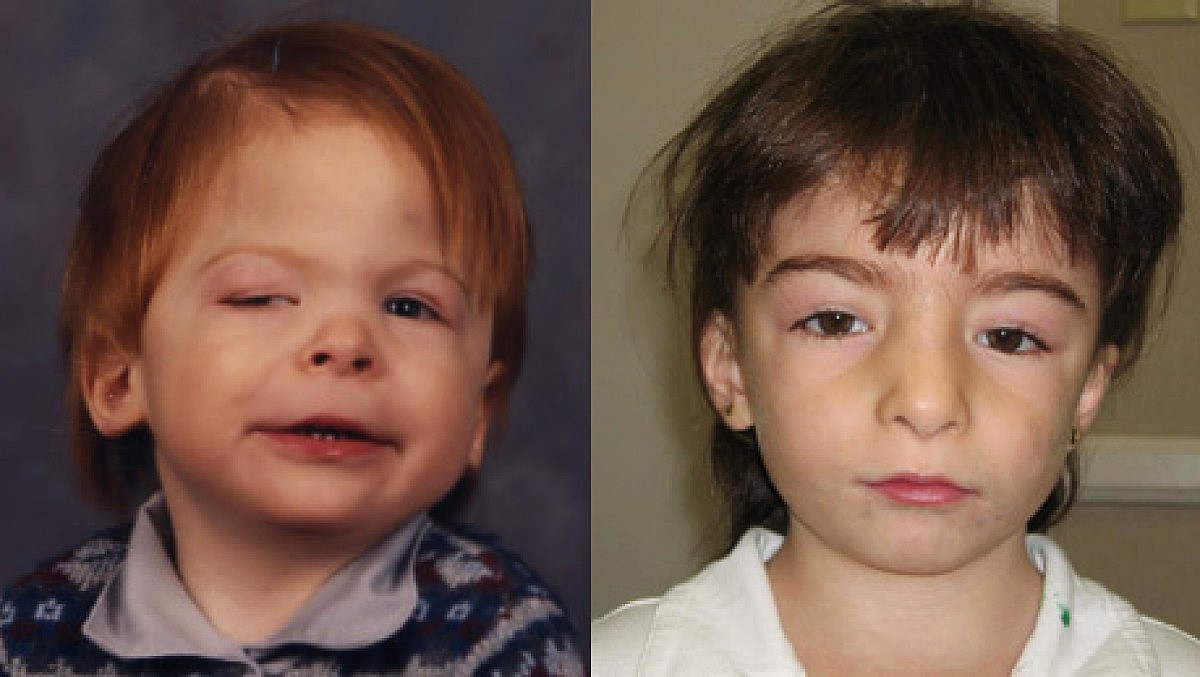
What is Jacobsen Syndrome? Jacobsen Syndrome, also called 11q terminal deletion disorder, is a rare genetic condition caused by the loss of a portion of chromosome 11. Affecting about 1 in 100,000 births, this syndrome leads to various developmental challenges and physical anomalies. More common in females, it presents a wide range of symptoms, including distinctive facial features, cognitive impairments, and heart defects. Individuals with Jacobsen Syndrome often face lifelong medical and developmental hurdles, requiring comprehensive care from multiple specialists. Understanding this condition is crucial for early diagnosis and effective management, improving the quality of life for those affected.
What is Jacobsen Syndrome?
Jacobsen syndrome, also known as 11q terminal deletion disorder, is a rare genetic condition caused by the partial deletion of the long arm of chromosome 11. This disorder impacts various aspects of development, leading to a wide range of physical and cognitive symptoms. Here are some key facts about this condition:
- Definition: Jacobsen syndrome results from the partial deletion of the long arm (q arm) of chromosome 11.
- Incidence: It affects approximately 1 in 100,000 births, with over 200 reported cases worldwide.
- Female to Male Ratio: The condition is more common in females, with a female to male ratio of 2:1.
- Causes: The deletion typically occurs at the end of the long arm of chromosome 11, but it can also occur within the long arm, known as an interstitial deletion.
- Genetic Material Loss: The size of the deletion varies, but most affected individuals miss between 5 million to 16 million DNA base pairs. Larger deletions tend to cause more severe symptoms.
- Gene Loss: The deleted region contains between 170 to over 340 genes, which are critical for normal development, including brain, facial features, and heart development.
Clinical Features of Jacobsen Syndrome
Jacobsen syndrome presents with a variety of clinical features that can affect multiple systems in the body. Here are some of the common symptoms and characteristics:
- Clinical Features: Common features include pre- and postnatal growth retardation, psychomotor retardation, and characteristic facial dysmorphism.
- Facial Dysmorphism: Distinctive facial features include wide-set eyes with droopy eyelids (hypertelorism and ptosis), skin folds covering the inner corners of the eyes (epicanthal folds), a broad nasal bridge, downturned corners of the mouth, a small lower jaw, and a thin upper lip.
- Head Size: Many individuals with Jacobsen syndrome have macrocephaly, or a larger-than-average head size, and trigonocephaly, which gives the forehead a pointed appearance.
- Developmental Delays: Most affected individuals experience delayed development of certain skills, including speech and motor skills such as sitting, standing, and walking.
- Cognitive Impairment: Cognitive impairment is a hallmark of Jacobsen syndrome, leading to learning difficulties and intellectual disability in approximately 97% of cases.
- Behavioral Problems: Behavioral problems such as compulsive behavior, easy distractibility, and short attention span are common. Many patients also have attention-deficit/hyperactivity disorder (ADHD).
- Autism Spectrum Disorder: There is an increased likelihood of autism spectrum disorder, characterized by impaired communication and socialization skills.
Health Complications Associated with Jacobsen Syndrome
Jacobsen syndrome can lead to several health complications that require ongoing medical attention. Here are some of the common issues:
- Platelet Disorders: More than 90% of individuals with Jacobsen syndrome have a bleeding disorder called Paris-Trousseau syndrome, which causes a lifelong risk of abnormal bleeding and easy bruising.
- Heart Defects: Heart defects, such as underdevelopment of the left side of the heart (hypoplastic left heart syndrome), are common complications.
- Kidney Problems: Affected individuals may have kidney issues, including having a single kidney, double ureters, hydronephrosis, or swelling cysts.
- Gastrointestinal Issues: Gastrointestinal problems such as pyloric stenosis (causing forceful vomiting), blocked or narrow anus, constipation, intestinal obstruction, and missing parts of the GI tract are also present.
- Ocular and Hearing Problems: Ocular issues like cataracts and frequent ear and sinus infections are common.
- Skeletal Abnormalities: Skeletal abnormalities can include short stature and various other bone-related issues.
- Feeding Difficulties: Some infants with Jacobsen syndrome experience feeding difficulties in infancy.
Life Expectancy and Mortality
Understanding the life expectancy and mortality rates associated with Jacobsen syndrome can help families prepare for the future. Here are some important facts:
- Life Expectancy: The life expectancy of individuals with Jacobsen syndrome is unknown, but complex heart defects and bleeding disorders are leading causes of death.
- Mortality Rate: Approximately 20% of children with Jacobsen syndrome die during the first two years of life due to complications from heart defects and bleeding disorders.
Diagnosing Jacobsen Syndrome
Accurate diagnosis is crucial for managing Jacobsen syndrome effectively. Here are some key points about the diagnostic process:
- Diagnostic Procedures: Diagnosis is based on clinical findings such as thrombocytopenia, intellectual deficit, and facial dysmorphic features, confirmed by cytogenetic analysis.
- Differential Diagnosis: Clinical features of Jacobsen syndrome can be shared with Turner and Noonan syndromes, such as short and wide neck, short stature, ptosis, pulmonary or aortic stenosis, and down-slanting palpebral fissures.
- Balanced Translocation: Between 5 and 10% of cases are caused by a deletion from a balanced parental chromosome translocation or rearrangement. In these cases, the parent carries a chromosomal rearrangement called a balanced translocation.
- De Novo Origin: The majority of Jacobsen syndrome cases (85-92%) are of de novo origin, meaning they occur randomly during the formation of reproductive cells or early fetal development.
- Inheritance Risk: If one parent has Jacobsen syndrome, the recurrence risk for another child is 50%. However, most cases are not inherited.
- Genetic Testing: Genetic testing is necessary to confirm a diagnosis of Jacobsen syndrome. This involves evaluating magnified chromosomes under a microscope and staining them to give them a “barcode” appearance, making the broken chromosome and deleted genes visible.
- Prenatal Diagnosis: Jacobsen syndrome can be diagnosed during pregnancy if an ultrasound flags any abnormalities. Further testing may include a blood sample from the mother for analysis.
Managing Jacobsen Syndrome
Managing Jacobsen syndrome requires a multidisciplinary approach to address the various symptoms and complications. Here are some important aspects of care:
- Multidisciplinary Care: Post-diagnosis, a complete evaluation by a multidisciplinary team including a pediatrician, cardiologist, neurologist, physical therapist, ophthalmologist, and other specialists is crucial for managing the condition.
- Medical Management: Newborns diagnosed with Jacobsen syndrome often require specialized assistance and treatment. Medications may be used to manage complications of heart defects and platelet abnormalities.
- Surgical Interventions: Children with Jacobsen syndrome may require surgery, especially for those with cardiac malformations. Hematologic complications need to be considered preoperatively.
- Behavioral Therapy: Behavioral therapy may be necessary to address compulsive behavior, distractibility, and short attention span. This can include strategies for managing ADHD and autism spectrum disorder symptoms.
- Educational Support: Educational support is essential for individuals with Jacobsen syndrome to manage learning difficulties and intellectual disability. Special education programs can help tailor learning to their needs.
- Physical Therapy: Physical therapy is important for addressing developmental delays in motor skills. This can include occupational therapy to improve daily functioning and mobility.
- Ophthalmological Care: Regular ophthalmological care is necessary to monitor and manage ocular issues such as cataracts and frequent eye infections.
- Ear and Sinus Infections: Frequent ear and sinus infections require prompt medical attention to prevent complications. Antibiotics may be prescribed to manage these infections.
- Nutritional Support: Nutritional support is crucial for managing feeding difficulties in infancy and ensuring adequate nutrition throughout life. This may involve specialized diets or feeding tubes if necessary.
- Psychological Support: Psychological support is essential for individuals with Jacobsen syndrome and their families. Counseling can help cope with the emotional challenges associated with the condition.
- Research and Awareness: Ongoing research is necessary to better understand the genetic mechanisms underlying Jacobsen syndrome and to develop more effective treatments. Awareness campaigns can help raise public understanding of this rare condition, promoting early diagnosis and better care for affected individuals.
Understanding Jacobsen Syndrome
Jacobsen syndrome, a rare genetic disorder, affects many aspects of development. With a prevalence of about 1 in 100,000 births, it presents a wide range of symptoms, from distinctive facial features to cognitive impairments. Most individuals experience developmental delays, intellectual disabilities, and behavioral issues. Heart defects, platelet disorders, and other health complications often accompany the condition. Diagnosis involves genetic testing, and management requires a multidisciplinary approach, including medical, surgical, and therapeutic interventions. Early diagnosis and comprehensive care can improve the quality of life for those affected. Awareness and research are crucial for better understanding and treatment. Families facing Jacobsen syndrome need support and resources to navigate the challenges. By spreading knowledge, we can foster a more inclusive and supportive environment for individuals with this condition.
Was this page helpful?
Our commitment to delivering trustworthy and engaging content is at the heart of what we do. Each fact on our site is contributed by real users like you, bringing a wealth of diverse insights and information. To ensure the highest standards of accuracy and reliability, our dedicated editors meticulously review each submission. This process guarantees that the facts we share are not only fascinating but also credible. Trust in our commitment to quality and authenticity as you explore and learn with us.


